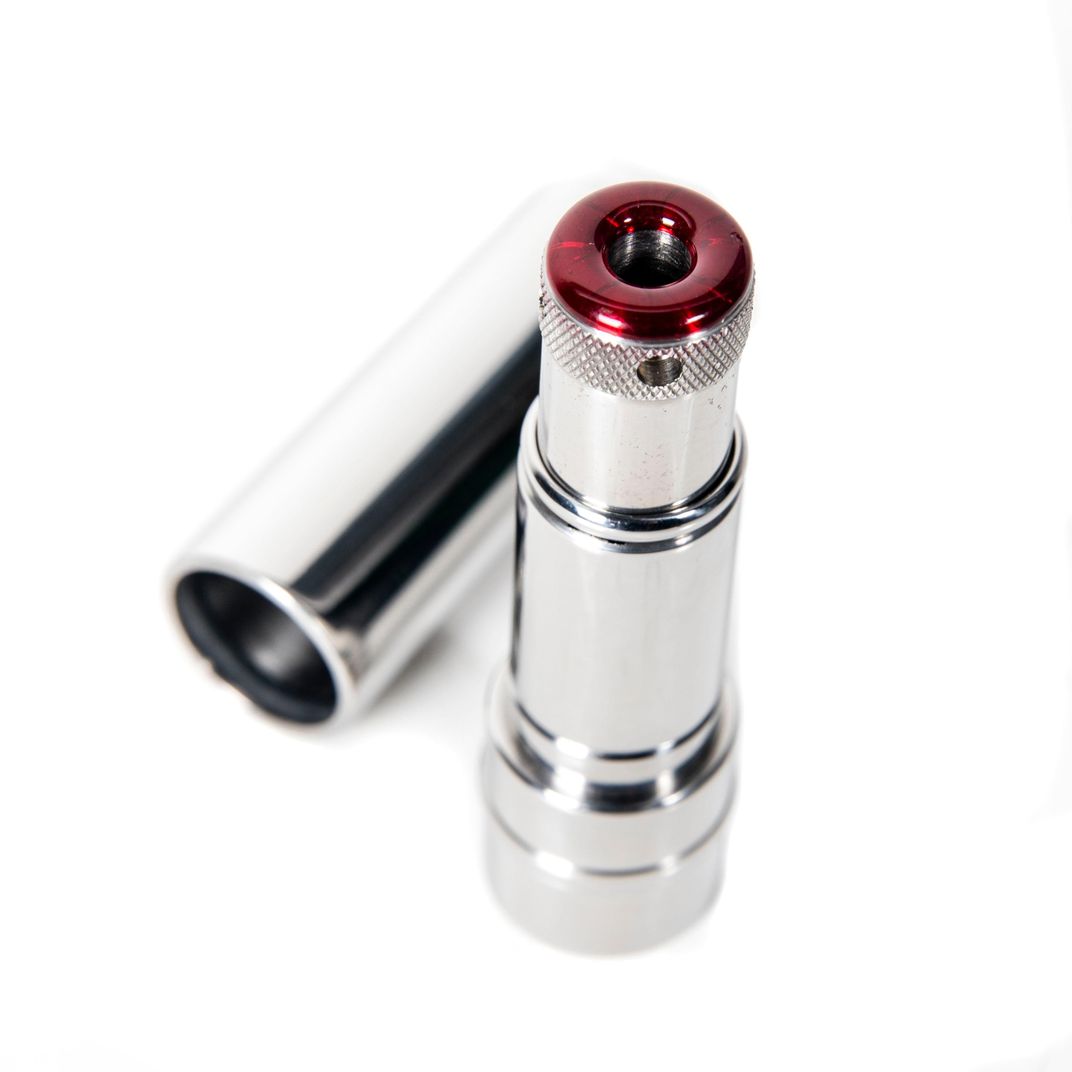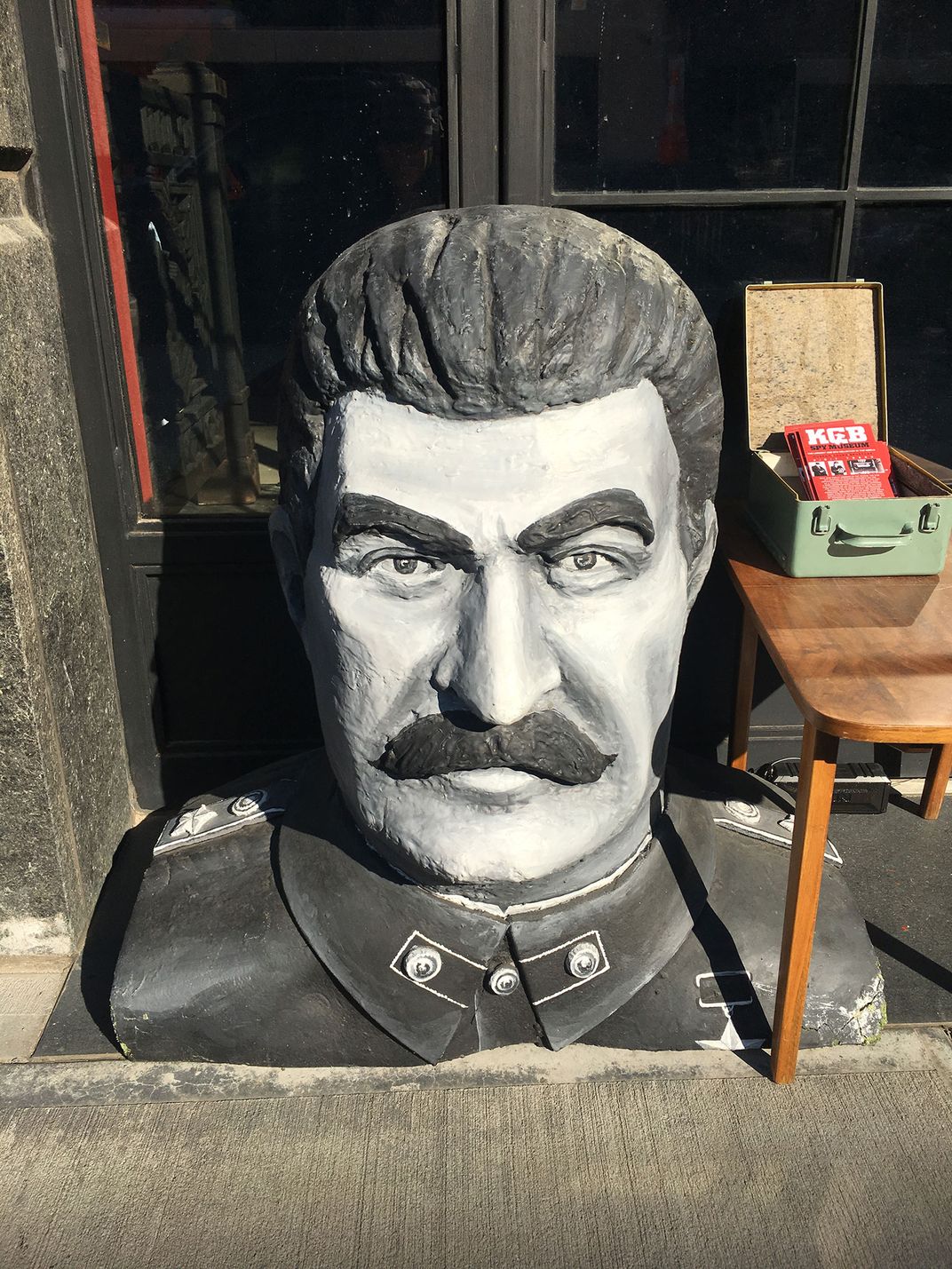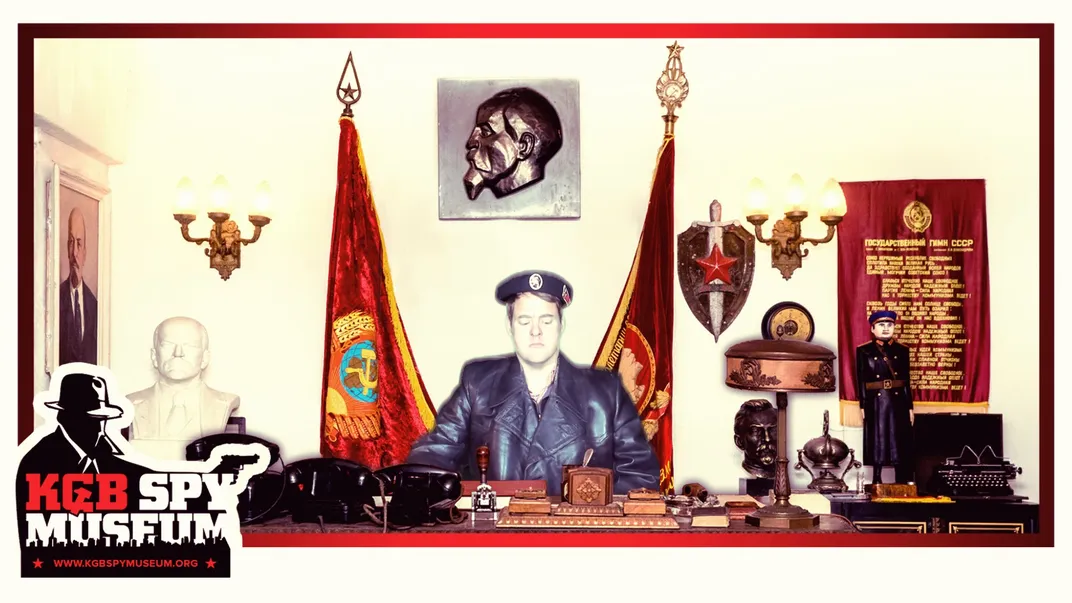The Incomplete History Told by New York’s K.G.B. Museum
Designed to be apolitical, the attraction offers whiz-bang tech without the agency’s brutal past
/https://tf-cmsv2-smithsonianmag-media.s3.amazonaws.com/filer/11/63/11635529-f675-47c2-9b3e-0d128660470e/156_2.jpg)
After downing a second vial of “baby blue truth serum,” which mysteriously tasted like vodka, I admitted something to myself. I wasn’t enjoying the sardine-and-hard-boiled-egg appetizer at the opening night party for the new KGB Spy Museum in downtown Manhattan. Everything else on that chilly January night, however, was otlichno. As an accordionist played post-war Russian pop songs, the assembled mix of media and other guests toured the museum.
The native Russian guides highlighted some of the 3,500 items on display, with a break for us to strap in and pose in the replica psychiatric hospital torture chair (drilling into teeth to the jawline, thankfully not included). Among the other stops in the tour were picking up the phone to receive messages from former enemies like Nikita Khrushchev and Yuri Andropov (or current frenemy Vladimir Putin), getting creeped out by the one-night only live model in the straitjacket (normally, a mannequin), and examining a half-century’s worth of espionage devices that defined the Cold War. My personal favorite? The “Deadly Kiss,” a single-shot lipstick gun the museum claims was specifically designed for female spies to use against targets in the boudoir. Sex sells. And kills.
However, on a return visit a few days later in the sober morning hours, the museum had a different feel. Donning a full-length leather commissar’s coat and military hat for the Instagram-ready photo at K.G.B. officer’s desk was kitschy fun in the moment, but the genocidal history of the Soviet regime that undergirds the history of it all can easily get lost in the whole Spy vs. Spy, Get Smart, “Moose and Squirrel” vibe.
The KGB Spy Museum opened last month and chronicles the evolution of the Soviet secret police from the 1917 founding of Vladimir Lenin’s Cheka on through Joseph Stalin’s NKVD, led by mass murderer Lavrentiy Beria. (Referred to by Stalin as “our Himmler,” Beria’s bio and bust are an early tour “highlight.”) The bulk of the museum is dedicated to the Komitet Gosudarstvennoy Bezopasnosti (K.G.B.), in English the “Committee for State Security,” founded in 1954 and active until 1991 with the dissolution of the Soviet Union.
The USSR used the K.G.B. to quell dissent, by whatever violent means necessary, and run general surveillance on its citizenry as part of its efforts to maintain Communist order. During the Cold War, the K.G.B. rivaled the C.I.A. around the globe, but primarily carried out its most brutal acts behind the Iron Curtain. A 1980 U.S. intelligence report asserted that at its peak, the K.G.B. employed some 480,000 people (along with millions of informers) and infiltrated every aspect of life in the Soviet Union—one dissident Orthodox priest said in the 1970s that “one hundred percent of the clergy were forced to cooperate with the K.G.B.”
Although no official accounting of the total atrocities committed by the K.G.B. exists, estimates place multiple millions of Russians in forced labor camps known as gulags, or to their deaths, both at home and abroad. The K.G.B. was instrumental in crushing the Hungarian Revolution of 1956 and the Prague Spring of 1968.When a collection of documents related to the K.G.B.’s work in Prague was released and examined by reporters and historians, it became abundantly clear that of all the weapons used by the agency, fear was the most pervasive. "They considered the worst enemies those who could influence public opinion through media,” said Milan Barta, a senior researcher at Prague's Institute for Study of Totalitarian Regimes in a 2014 interview with the Washington Examiner. Unsuccessful plots by the K.G.B. included the kidnapping of novelist Milan Kundera and the silencing of other key public figures.
The brains behind the KGB Spy Museum, are not professionally trained curators or historians, however, and instead are a Lithuanian father-daughter team, Julius Urbaitis and Agne Urbaityte. Urbaitis, 55, began collecting World War II items as a young man. His taste for authentic artifacts is obsessive—at one point he had the largest collection of gas masks in Europe. Their display is certainly extensive, but it is personal, not one curated by academics .
“Our mission is to tell the exact historical information, no politics, to show what technologies were used then, and what are used now,” says Urbaityte, 29, who, along with her father, only came to New York from Lithuania three months ago and are anxiously awaiting work visas. “We have extremely rare items and there is no collection like this in the world.”
Urbaitis is a writer, scholar, and lecturer, but first and foremost, a collector. Not everything on view in his museum has dates or labels about the provenance, putting visitors in the position to take a leap of faith along with the collectors. For example, the write-up of the lipstick gun says it was “most likely used in the bedroom…”

In 2014, after some three decades of assembling his items, the duo opened the Atomic Bunker Museum, housed 20 feet underground, in Kaunas, Lithuania. In the last few years, Lithuanian tourism has been on the rise, and their museum became a must-see attraction. Inspired by the museum’s popularity, a group of anonymous American collectors asked Urbaitis to evaluate their artifacts, which ultimately led to an unnamed entrepreneur funding the for-profit KGB Spy Museum (and its presumably whopping monthly rent).
“When Dad gets interested in something, he wants to know everything about it,” says Urbaityte. “Whatever it is—motorcycles, old cars, listening devices—he figures out how it works, becomes an expert, and moves on to the next topic. He understands how [every object] works in the museum.”
As he gave an interview to Channel One Russia clad in a trench coat and blue-tinted aviator sunglasses, Urbaitis looked the part of the dashing Cold War spy, and his collection is certainly thorough. It’s laid out in a snaking format with various sections dedicated to bugs, lie detectors, cameras of all sizes, cassette recorders, dictaphones, night vision goggles, radios, and a corner section with concrete prison doors. A standout piece is the Great Seal, better known as “The Thing,” a wooden U.S. coat of arms given as a gift from Soviet schoolchildren to American ambassador W. Averell Harriman in 1943. It hung in his Moscow office until 1952, but hidden inside was a 800 megahertz radio signal that “acted like a mirror reflecting light” and required no power supply for eavesdropping.

Urbaitis collected sillier items, too. Rubber bald head wigs and community theater clown makeup provide a good reminder that not all spy technology was sophisticated. Kids can get their espionage on as well, playing “Spot the Spy” on interactive tablets arranged amidst the cutting-edge suitcase phones of the 1960s. At $25 a pop—$43.99 for a two-hour guided stroll—the KGB Spy Museum offers a thoroughly capitalist look at the decidedly Communist spy tools, from the Bolshevik era through the F.S.B. of today. Among its most current objects is a hollowed out “tree with eyes” with a hard drive from 2015. Altogether, touring the museum provides an engaging journey of the development of Soviet spy technology, but the bust of Joseph Stalin, a ruthless dictator who killed 20 million of his own people, haunting the entrance to the museum looms over the visitor experience as well.

Yet in order to remain “apolitical,” Urbaitis and his daughter run the risk of ignoring the geopolitical realities past and present. The technological specs and encyclopedia-style write-ups of the items don’t put the K.G.B. reign of terror in a larger global context. In the New Yorker, Russian-American journalist Masha Gessen writes the museum resembles one you might find in Russia, “a place where the K.G.B. is not only glorified and romanticized but also simply normalized.”
It’s understandable why Urbaityte refers to the museum as “historical” and “educational” as opposed to “political”—the very word politics causes some people to roll their eyes and move onto the M&M’s World, but ignoring the 21st-century state of affairs sells short the importance and evolution of the collection itself. Showcasing a facsimile of the ricin-tipped umbrella used to assassinate dissident Georgi Markov in 1978 is worthwhile, but not mentioning the 2006 poisoning of former Russian spy Alexander Litvinenko, at the behest of the former K.G.B. agent who okayed the meddling in the 2016 U.S. Presidential election, is conspicuous.

A bigger concern is the absence of the full picture of abject human suffering caused by the Soviet state police. The fine print of exhibit labels share some gory details of various torture apparatuses, but the museum includes no all-encompassing look at the K.G.B. atrocities and how it relates to the 21st-century. Take Afghanistan, for instance. In The Sword and the Shield, British historian Christopher Andrew and former K.G.B. officer Vasili Mitrokhin (who defected to the U.K. in 1992 with 25,000 pages of documents) detail how the K.G.B. concealed the horrors of the Afghan War—15,000 Russian soldiers killed, a million Afghani deaths, and four million refugees—from the Soviet people. You won’t find mention of it, or how it gave rise to the Taliban, in the museum, even as new American museums have sought to tell the full ugly chapters of American history. That list includes a reconciliation with lynchings and racial terror at The National Memorial for Peace and Justice and the tucked-away corner dedicated to those who jumped to their deaths at the 9/11 Memorial and Museum. Gessen, postulates no American museum would ever present the head of Adolf Hitler out on the sidewalk, adding, “And yet, for the American public, an entertaining presentation of what was probably the most murderous secret-police organization in history seems both unproblematic and commercially promising.”
Nor is there a mention of the hundreds of thousands of Lithuanians murdered or sent to the gulags during the Soviet occupation.
1.6-million Russians-Americans live in the New York metropolitan area, with some 600,000 in New York City alone. Considering the K.G.B. only disbanded in 1991, and that the current president of Russian, Vladimir Putin, was himself once a K.G.B. agent, many of the museum’s neighbors likely lived through the state security nightmare and might want their pain acknowledged beyond video-monitoring birdhouses and ashtrays that listen to you smoke.
The museum’s physical collection is astounding, and by the metric of showing off how espionage technology evolved, it succeeds. Visitors should know, however, there’s a lot more to K.G.B. history than meets the spy.
Editor's note, February 9, 2019: An earlier version of this story included a photo of Lenin, rather than Stalin, at the entrance to the museum. We have updated it to include a new photo featuring the correct Soviet leader.
/https://tf-cmsv2-smithsonianmag-media.s3.amazonaws.com/accounts/headshot/IMG_2851_thumbnail_copy.png)

/https://tf-cmsv2-smithsonianmag-media.s3.amazonaws.com/accounts/headshot/IMG_2851_thumbnail_copy.png)